What are the links between emotional intelligence and leadership performance? New research shows 66% of the variation in scores on leadership outcomes are predicted by five key leadership drivers – and people with higher emotional intelligence are seven times as likely to earn high scores on these factors. Since 2007 the Vitality study (6sec.org/vitality) has tracked changing trends on emotional intelligence in the workplace; the 2020 installment drills into individual leadership effectiveness and the role of emotional intelligence – particularly in terms of strengthening trust and building capacity for change.
For decades, theorists have proposed a linkage between emotional intelligence and leadership, and numerous studies have found some associations between these two. Until now, however, there has not been a clear understanding of the specific dynamic between emotional intelligence (EQ) capabilities and how these impact leadership in the real world.
To understand the key ingredients that drive leadership effectiveness, 1325 people from 70 countries (see About the Study for additional demographics) participated in the Vital Signs 2019 study using two entirely independent validated assessment tools, plus a short questionnaire:
- Leadership Vitality (Leadership Vital Signs, “LVS”)
- Emotional Intelligence (Six Seconds Emotional Intelligence assessment,”SEI”)
- Survey on emotions in the workplace, derived from our ongoing study (which began as “Workplace Issues study” in 2007)
While the Leadership Vitality and Emotional Intelligence models have each been well validated, there was no previously published research to document the linkage between an individual’s emotional intelligence scores and specific leadership capabilities.
Measuring Leadership Effectiveness and Emotional Intelligence
Figure 1: The Vital Signs Model
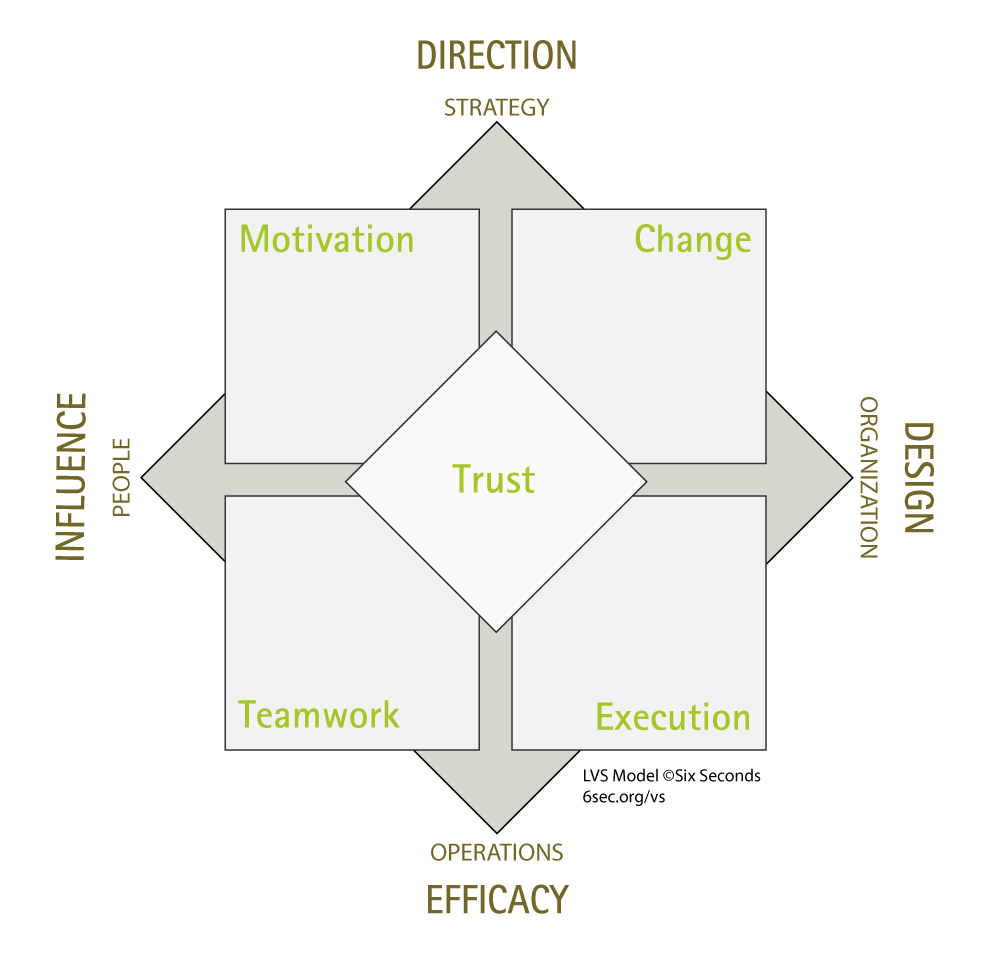
Emotional intelligence is the capacity to be “smarter with feelings,” to accurately acquire and effectively utilize emotional data. To make this concept actionable, Six Seconds created a model with three macro steps and eight competencies. Shown below (figure 2), the Six Seconds Model is measured by a normed, validated assessment called the “Six Seconds’ Emotional Intelligence” (or SEI) assessment.
Figure 2: The Six Seconds Model of Emotional Intelligence
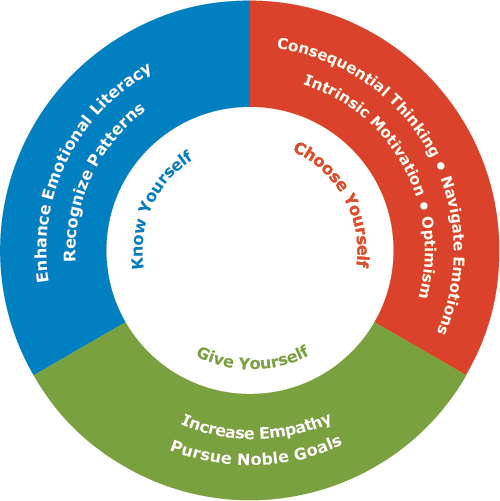
Six Seconds Model ©Six Seconds
6sec.org/eq
SEI Competencies Defined
| Pursuit | Competency | Definition |
|
Know Yourself
|
Enhance Emotional Literacy | Accurately identifying and interpreting both simple and compound feelings. |
| Recognize Patterns | Acknowledging frequently recurring reactions and behaviors. | |
|
Choose Yourself
|
Apply Consequential Thinking | Evaluating the costs and benefits of your choices |
| Navigate Emotions | Assessing, harnessing, and transforming emotions as a strategic resource. | |
| Engage Intrinsic Motivation | Gaining energy from personal values & commitments vs. being driven by external forces. | |
| Exercise Optimism | Taking a proactive perspective of hope and possibility. | |
| Give Yourself | Increase Empathy | Recognizing, connecting with, and appropriately responding to emotions. |
| Pursue Noble Goals | Connecting your daily choices with your overarching sense of purpose. |
SEI “Success Factors” or “Outcomes” Defined
Effectiveness – Capacity to generate results
Relationships – Capacity to build and maintain networks
Wellbeing – Capacity to maintain optimal energy and functioning
Quality of Life – Capacity to maintain balance & satisfaction
What is the Importance of “Vital Leadership”?
Before examining the linkage between the assessments, a crucial question: Do the five drivers measured in the Leadership Vital Signs tool matter?
To answer this question, we correlated scores on the five drivers mentioned above with key performance indicators (KPIs) from the Leadership Vital Signs assessment (LVS Outcomes):
Influence: building strong relationships to enroll people.
Efficacy: generating useful results.
Design: managing a smooth workflow with and through people.
Direction: setting a viable, powerful vision.
We combined these four KPIs into an overall variable called “Leadership Performance.” Likewise, the five drivers (Trust, Motivation, Change, Teamwork, Execution) we combined into a single variable called “Leadership Vitality.”
There is a strong positive correlation between Leadership Vitality and Leadership Performance (R2=.66, p< 0.03). This correlation is visually depicted in the graph below (figure 3).
Figure 3: Leadership Vitality (LVS Drivers Combined) vs Leadership Performance (LVS Outcomes Combined)
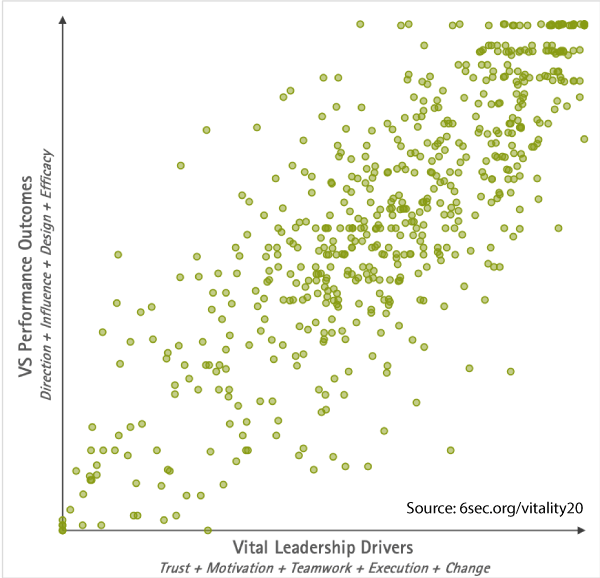
Given the speed of change and intense complexity of the workplace — even in 2019 — perhaps it will be unsurprising that CHANGE is the most powerful of the five Drivers.
The Value of Emotional Intelligence for Leaders
For over two decades, researchers and authors have sought to make the case that emotional intelligence is a key to leadership effectiveness. Six Seconds’ publication, The Business Case for Emotional Intelligence, summarizes a wide range of academic research. There is also a broad collection of real-world business case studies linking emotional intelligence to improved leadership, stronger teamwork, more profitable customer relationships, and sustaining employee performance. However, the exact dynamics of this link between EQ and leadership effectiveness has been elusive. For the first time, the Vitality study reveals specific aspects of leadership that are most influenced by emotional intelligence.
The first question is to consider the hypothesis that EQ is linked to Vital Leadership. At a macro level, as shown in Figure 4, respondents in the highest quartile of EQ scored 19.5% higher on the 5 drivers of Leadership Vitality than those in the lowest quartile of EQ scores.
To express this in a more compelling summary, we used an odds-ratio calculation to say: People who are high on EQ are 7x as likely to have high scores on the Leadership Vital Signs.
Figure 4: Connection Between Emotional Intelligence and Leadership Vitality
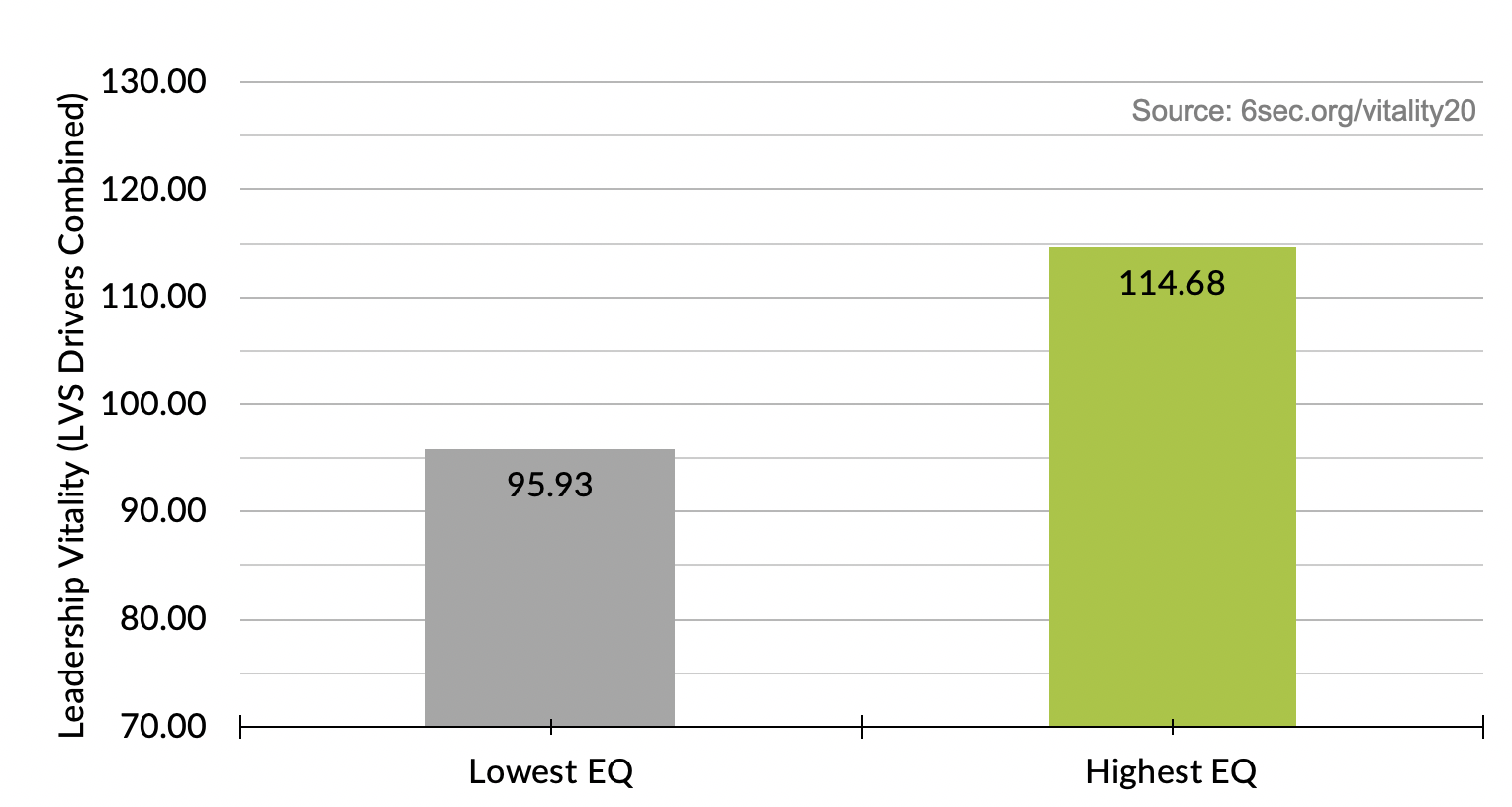
l8
Which Aspects of Leadership are Driven by EQ?
The Vitality data was collected throughout 2019. It seems likely that by Q2 of 2020, the pandemic would change some of these findings — but even in 2019, the research reveals important lessons about leadership (later in 2020, we will publish the State of the Heart research to explore the effects of the pandemic on EQ. Click here to participate and learn more
The first consideration we made to assess this relationship was to test: Which of the LVS Drivers (Trust, Motivation, Teamwork, Execution, Change) had the most significant impact on Leadership Performance (combination of LVS outcomes: Direction, Influence, Efficacy, Design)?
Given the speed of change and intense complexity of the workplace — even in 2019 — perhaps it will be unsurprising that CHANGE is the most powerful of the five Drivers. Organizations are grappling with constant changes, from covidization, to implementing new processes, to M&A, to restructuring. This driver is about a leaders capacity to imagine and execute change; it includes change readiness, brining people into the change process to build buy-in, and managing the change process,
Using R-Squared, a test of predictive validity, we found 58% of the variation in combined outcomes is predicted by Change scores. Here is the R measure of correlation between each Driver and the combined outcomes.
Stats on EQ & Leadership
How scores on each Driver are predicting the combined Leadership Performance Outcome: Trust r2=0.48 p=0.01, Motivation r2=0.49 p=0.00, Teamwork r2=0.45 p=0.06, Execution r2=0.43 p=0.89, Change r2=0.58 p=0.00
Interpretation on EQ & Leadership
Each “driver” appears to make a large contribution to the combined outcomes, and most have a very strong statistical significance. Change is the most powerful of the drivers with a massive and highly significant contribution to Leadership Performance (combined LVS outcomes).
These emotional intelligence tools make a strong and statistically significant contribution to a leader’s capacity to engage people in change — which in turn has a large impact on leadership performance.
What Drives Change?
Recall that the SEI measures the eight competencies in the Six Seconds Model, as well as the 18 “Brain Talents” which are behavioral tools for implementing emotional intelligence. Essentially these models provide a “how to” process for leaders to put emotional intelligence into action.
The EQ competency most correlated with scores on Change is “Exercise Optimism,” which Six Seconds defines as “taking a proactive perspective of hope and possibility.” In a business context, Exercise Optimism might look like envisioning new possibilities and finding creative solutions. In a meeting, a leader strong in this skill will maintain openness and know there is a path forward, even when that path is unclear. As shown in Figure 5, scores on Exercise Optimism predict 31% of the variation in the LVS Driver of Change.
Figure 5: How Do Emotional Intelligence and Leadership Vitality Interact?
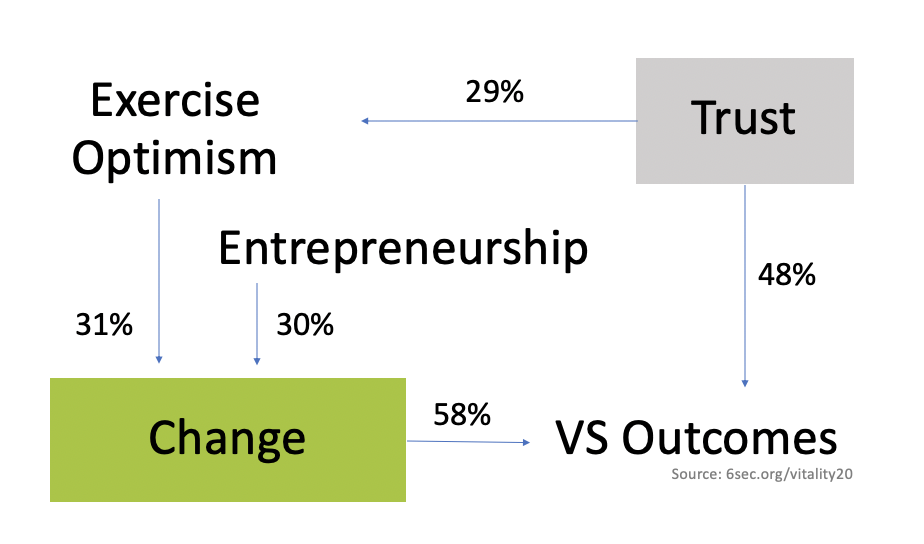
The Brain Talent most predictive of high scores on Change is Entrepreneurship, which predicts 30% of the variation in Change scores. Six Seconds defines Entrepreneurship as: “Inventing solutions to future challenges,” and the Brain Talent Interpretation Guide notes that the talent of Entrepreneurship is about vision + action: “To build a path toward the vision, you see the future and find energy to take steps toward it today.”
Stats on EQ & Change
Exercise Optimism scores predicting Change scores: R2=.31, p=0.00
Entrepreneurship predicting Change scores: R2=.30, p=0.00
Interpretation on EQ & Change
These emotional intelligence tools make a strong and statistically significant contribution to a leader’s capacity to engage people in change — which in turn has a large impact on leadership performance.
The power of Exercise Optimism and Entrepreneurship is in a proactive orientation to the world. Both involve taking ownership, feeling agency, and being future-focused. So, leaders who are able to foster a readiness for change will grow these capabilities in order to engage themselves and others in transformation. A plan is not enough: leaders need people to move the plan forward.
Trust As a Driver of Psychological Safety
There are numerous recent studies discussing psychological safety in the workplace; this boils down to trust. Have you ever worked for a leader who engendered distrust? How open were people to change in that context? A leader’s capacity to generate trust is key to forming inclusive teams where every voice is heard; leaders who build strong trust create opportunities for team members to innovate and experiment without retribution or blame for failures — even in stressful times where people are otherwise likely to become volatile. As shown in Figure 5, in addition to being a major driver of Leadership Performance (combined LVS outcomes), Trust also turns out to make a strong and significant contribution to leaders’ capacity to Exercise Optimism, creating a virtuous cycle between emotional intelligence, leadership vitality, and both leadership performance & personal outcomes.
Stats on EQ & Psychological Safety
Trust scores predicting Exercise Optimism scores: R2=0.29, p=0.00
Trust scores predicting Leadership Performance scores (combined LVS outcomes): R2=0.48, p=0.01
Trust scores predicting personal outcome scores (SEI outcomes): R2=0.34, p=0.00
Interpretation on EQ & Psychological Safety
A leader’s ability to engender trust plays a large and significant role in their capacity to Exercise Optimism, and to their personal and professional results.
As shown in the Vital Signs Model (Figure 1), trust is both conceptually and quantitatively central in the Vital Signs Model. Trust seems to be a mitigating factor that either expands or limits a leader’s efficacy in the other drivers. It makes sense, then, that this would also contribute to their capacity to grow and use emotional intelligence. This finding is important because in addition to EQ driving leadership effectiveness, we now have evidence of cycle where leadership capabilities are also improving EQ. In other words, psychological safety for team members also creates psychological safety for the leader, which fuels the future-orientation required for change agility.
…we now have evidence of cycle where leadership capabilities are also improving EQ. In other words, psychological safety for team members also creates psychological safety for the leader, which fuels the future-orientation required for change agility.
Sustaining Leadership: Trust & Resilience
As mentioned above, the Leadership Vital Signs are drivers both for the leadership outcomes and for the outcomes measured by the SEI: Effectiveness, Wellbeing, Quality of Life, and Relationships. These four outcomes are combined into a single variable: Personal Performance.
Stats on Sustaining Leadership
Leadership Vitality predicts Personal Performance; Trust is the key factor: R2=.34
Emotional intelligence predicts Personal Performance; Key factors are competencies called Pursue Noble Goal, Engage Intrinsic Motivation, and Exercise Optimism (R2 from .2 to .46).
In the Brain Talents, Resilience is the highest predictor; R2=.46
Interpretation on Sustaining Leadership
Linked to the importance of change agility, these three key EQ competencies are tied to a future-oriented action. Pursue Noble Goals is about putting vision into action. Engage Intrinsic Motivation is about self-driven energy. Exercise Optimism is about creating possibilities. Combined, these speak to building a path to the future. When we add Resilience as a key, we recognize that path is uncertain and fraught with challenge: Leaders with sustainable personal performance have both the future-focused-energy and the capacity to stay the distance.
About the Study
This phase of the Workplace Vitality study includes 1325 people who completed the surveys (described above), from 70 countries. Participants were recruited by email and social media to voluntarily complete the three questionnaires after reading the informed consent to participate. Of the responses, 610 were fully completed and statistically reliable. In addition to global diversity, the participants span a range of education and career backgrounds as shown in the graphs below.
To further assess the relationship between EQ and leadership, we did an analysis to see if responses from supervisors correlate with EQ in ways that are similar to the findings above. The LVS survey is a 360° assessment tool; in other words an individual takes the questionnaire about themselves (self assessment) and then invites others, such as supervisors, peers, team members, to provide feedback as well. These people providing feedback are called “raters.”
To look into the multi-rater perspective, we invited a random sampling of participants to invite raters. Then we compared the rater responses with the individual’s self-assessment of emotional intelligence (SEI).
In general, we found a positive correlation between the EQ scores and the raters’ scores that were similar to the findings reported above. However, the findings were not statistically significant. We surmise that we would need a much larger sample in order to complete this analysis, which we would like to do in the future.
In conclusion, while further research is needed (as usual!), these findings offer important insights to the essential ingredients to develop vital leadership skills for high performing leaders.
Figure 6: Sample Group by Role
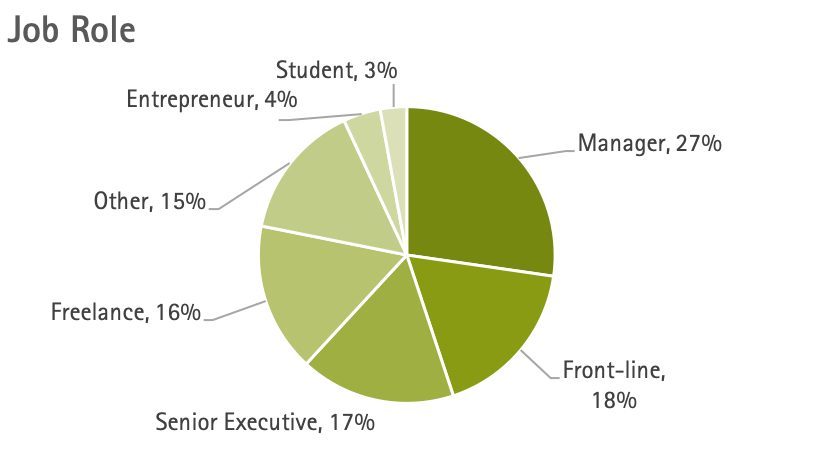
Figure 7: Sample Group by Gender
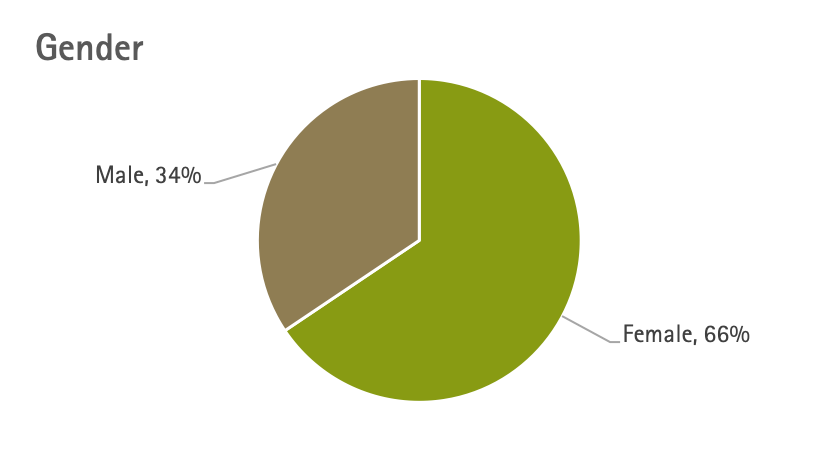
Figure 8: Sample Group by Education
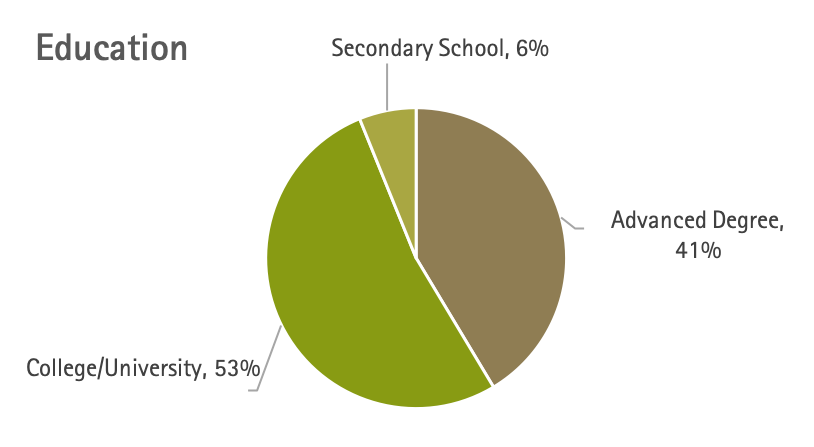
About the Authors

Joshua Freedman
Chief Executive Officer
Emotions can be a resource to connect us with what matters most. What if every person, of every age, everywhere, had the skills & support to grow their emotional intelligence?
What if EVERYONE could grow empathy so we connect more deeply…. Increase emotional literacy so we can share what’s really happening… Strengthen abilities to make choices on purpose to make tomorrow better?
That’s what I’m working on!

Tommaso Procicchiani
Design Engineer
Tom leads the research and development at Six Seconds and manages the team responsible for the systems, platforms and the EQ assessments published by Six Seconds. Tom is the coauthor and designer of numerous custom assessment tools including the TSI, EQFIT, SEI LTC, and many more. He is also the co-author of major research studies including, State of the Heart, Workplace Vitality and other academic research publications. Tom is also a musician and founder of the Thomas Ross Band.
- How Emotional Intelligence Coaches Use Emotions in Goal Setting - October 2, 2024
- 3 Winning Strategies for Successful Change Leadership: Coaching with Emotional Intelligence - September 4, 2024
- 3 Emotional Intelligence Tips for the Essence of Coaching - July 31, 2024

0 Comments